AI is revolutionizing the way we learn, research, and work. If used properly, it can help you 10x your productivity and income. To remain competitive in this new world, there is simply no option but to learn how to use ChatGPT and other AI tools.
This article will provide 7 actionable tips and tricks that will take you from a ChatGPT beginner to an advanced AI Prompt Engineer.
What is Prompt Engineering?
To maximize ChatGPT’s potential, you have to ask it the right questions. Prompt Engineering is the art of prompting ChatGPT in the most effective way to get the desired outcome. An advanced Prompt Engineer knows how to create the perfect prompts to get the perfect answer.
Here are 7 tips and tricks you can use to instantly get better answers from ChatGPT.
1. Give ChatGPT an identity
In the “real” world, when you seek advice, you look for experts in that field. You go to a trained investment specialist for financial advice and a personal trainer to get into shape. You wouldn’t ask a management consultant for the best way to treat the weird rash on your leg.
Treat ChatGPT in the exact same way. Whenever you are seeking advice or ideas, give ChatGPT the appropriate identity. Here are some examples:
- You want ChatGPT to write sales copy: “You are a professional copywriter. You have been providing copywriting services to businesses for 20 years. You specialize in writing copy for businesses in the finance sector.”
- You want career advice: “You are a professional career advisor. You have been helping young men (20-30) find their dream jobs for 20 years.”
- You want a healthy meal plan: “You are an expert nutritionist, health coach, and personal trainer. You have been helping people lose weight while gaining muscle for 20 years. Your clients are usually young men from 20 to 30 years old.”
You can see how powerful this prompt is in the following example.
When we tell ChatGPT it is an expert nutritionist before asking it to create a meal plan, it provides a much more comprehensive response. Rather than just listing out a plan for the day, it explains why it is a healthy meal plan, as well as other tips such as drinking water and limiting processed, high-fat foods.
Example WITHOUT giving ChatGPT an identity
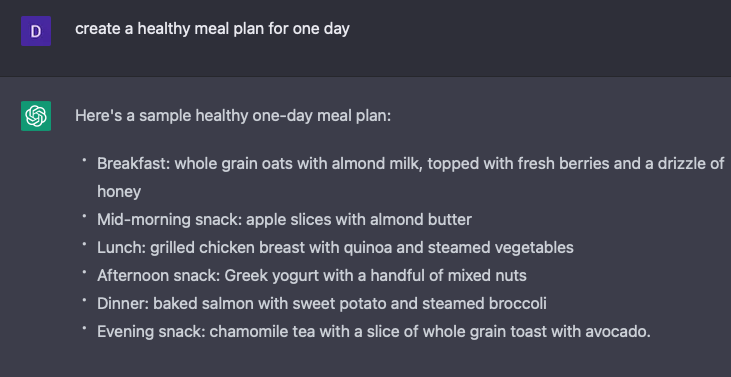
Example WITH giving ChatGPT an identity
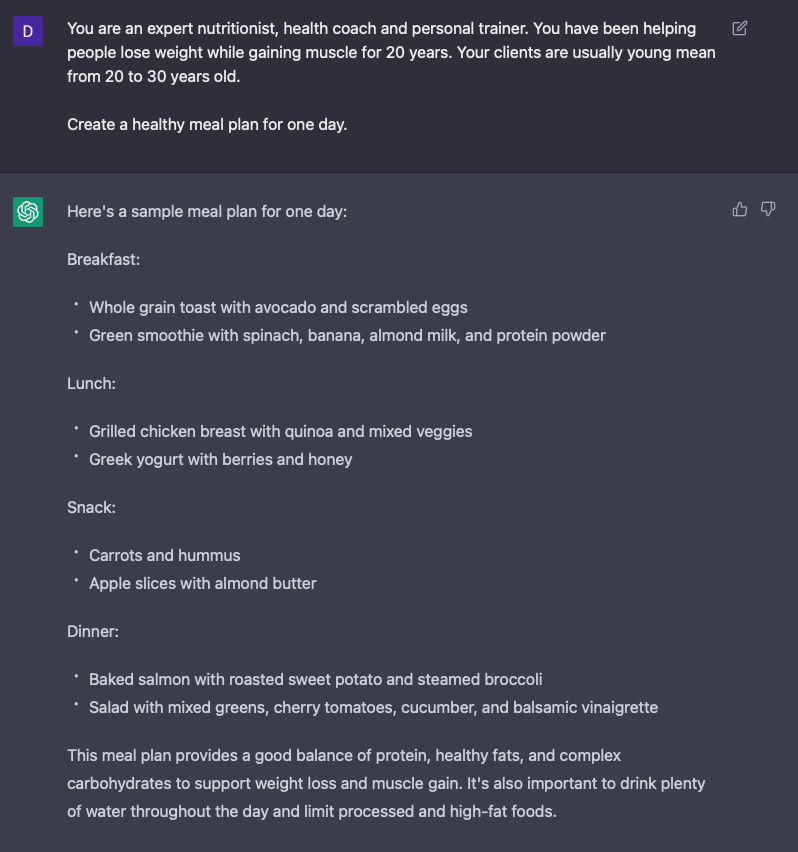
2. Define your objective
When ChatGPT knows what you want, its advice is much more catered to your needs. Simply tell ChatGPT what you are trying to achieve, and it will tailor its responses accordingly. Be as specific as possible about what your objective is.
Here’s an example when we ask ChatGPT to write a tweet about the importance of learning how to use ChatGPT.
Example WITHOUT defined objective

Example WITH defined objective
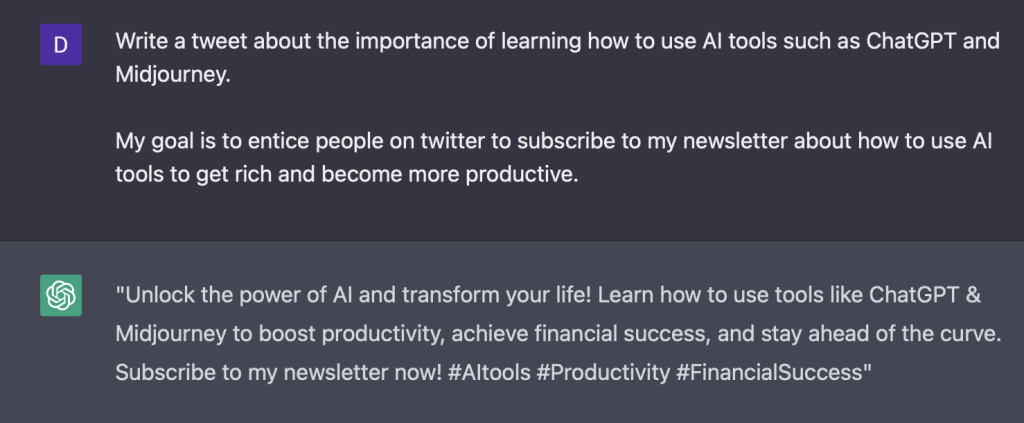
When we tell ChatGPT that the goal is to find subscribers for a newsletter, it makes the Tweet much more specific to the benefits of learning how to use ChatGPT. This kind of Tweet is significantly more likely to help us achieve our objective of converting people into newsletter subscribers.
3. Add constraints to your prompt
You can guide ChatGPT’s output by providing more details about what its answer should or should not be. Constraints help ChatGPT to understand what you are looking for and avoid irrelevant outputs. Here are some examples:
- Specify the length of the response: “Generate a 200-word summary of this news article.”
- Specify the format of the response: “Generate a table of keywords for a blog relating to gardening. Include “Example of article titles” and “target audience” as columns.”
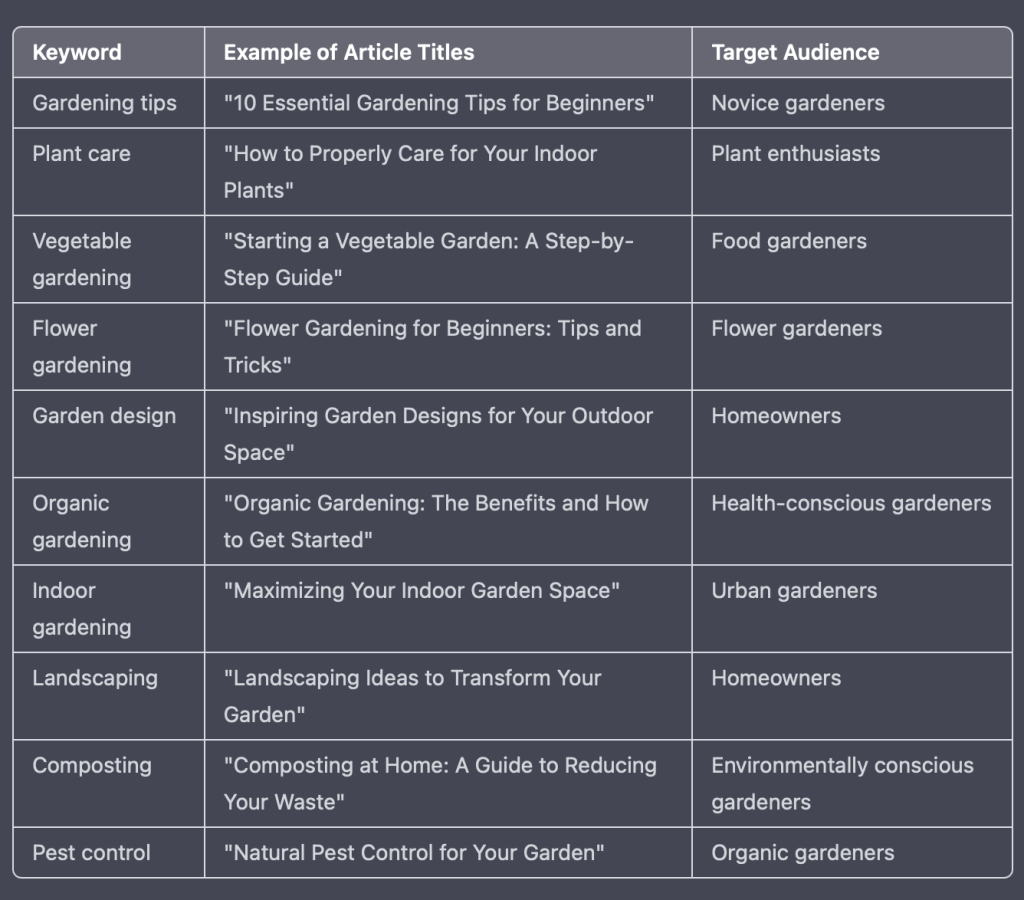
- Provide examples of the desired output: “Generate a poem about love, similar in style and tone to this example: ‘Love is a rose, delicate and sweet, a beauty to behold, a joy to meet. It blooms within our hearts, a fiery flame, and warms us through, in love’s sweet name.'”
4. Give ChatGPT a structure to follow
In copywriting and storytelling, there are tricks of the trade that all writers use to create persuasive and/or engaging content. Take advantage of this by asking ChatGPT to use these proven methods when completing a task.
- Writing a story: A good story usually follows a particular formula that involves conflict, character development, and a resolution. A former Pixar storyboard artist shared Pixar’s award-winning story formula, and you can use it as a prompt in ChatGPT.
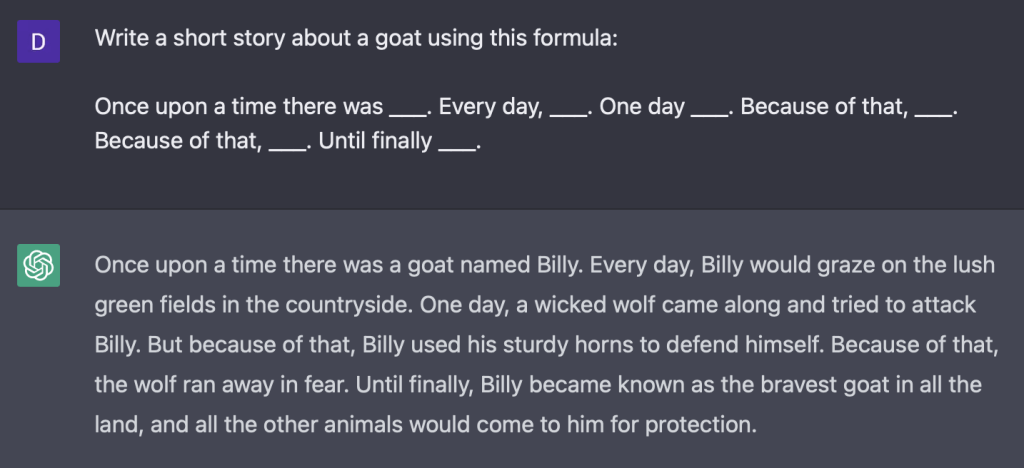
5. Refine the output through conversation
The beauty of ChatGPT is that it remembers the whole conversation within each chat. You can ask follow-up questions to dial down into a specific answer.
For example, let’s take the meal plan designed by ChatGPT (see section 1 of this article) and refine it with follow-up questions and requests.
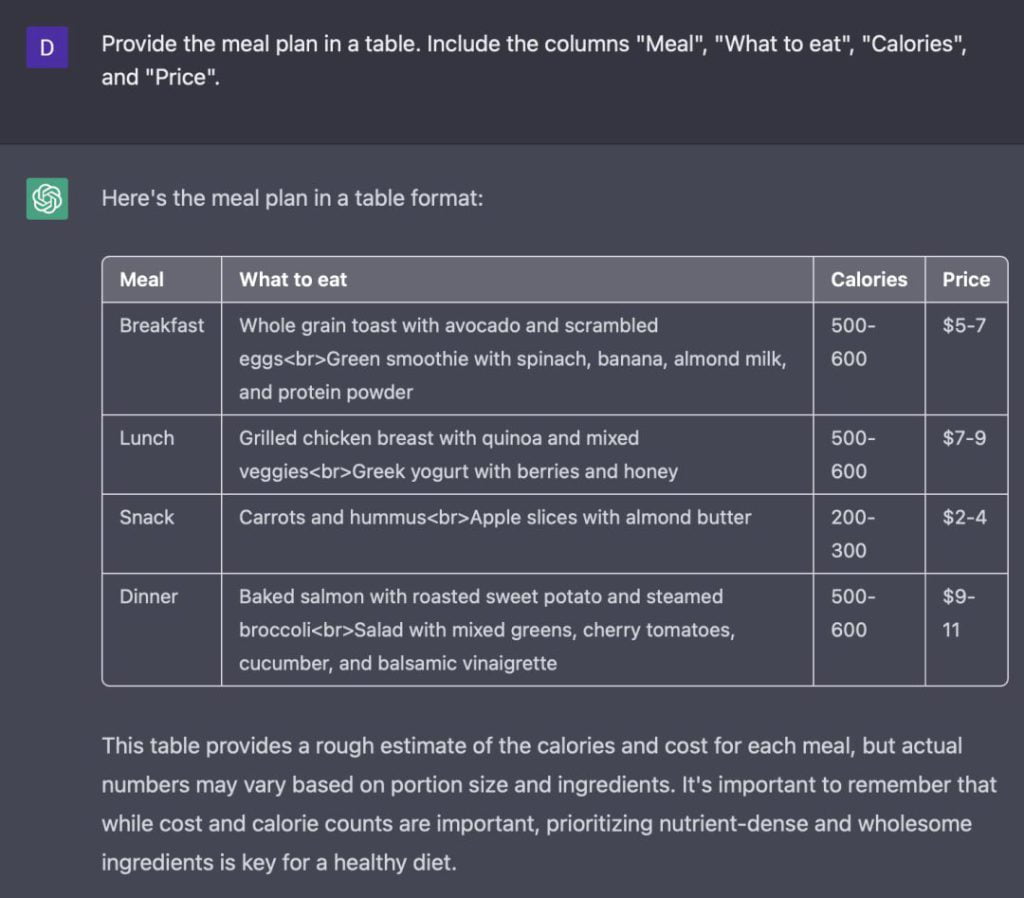
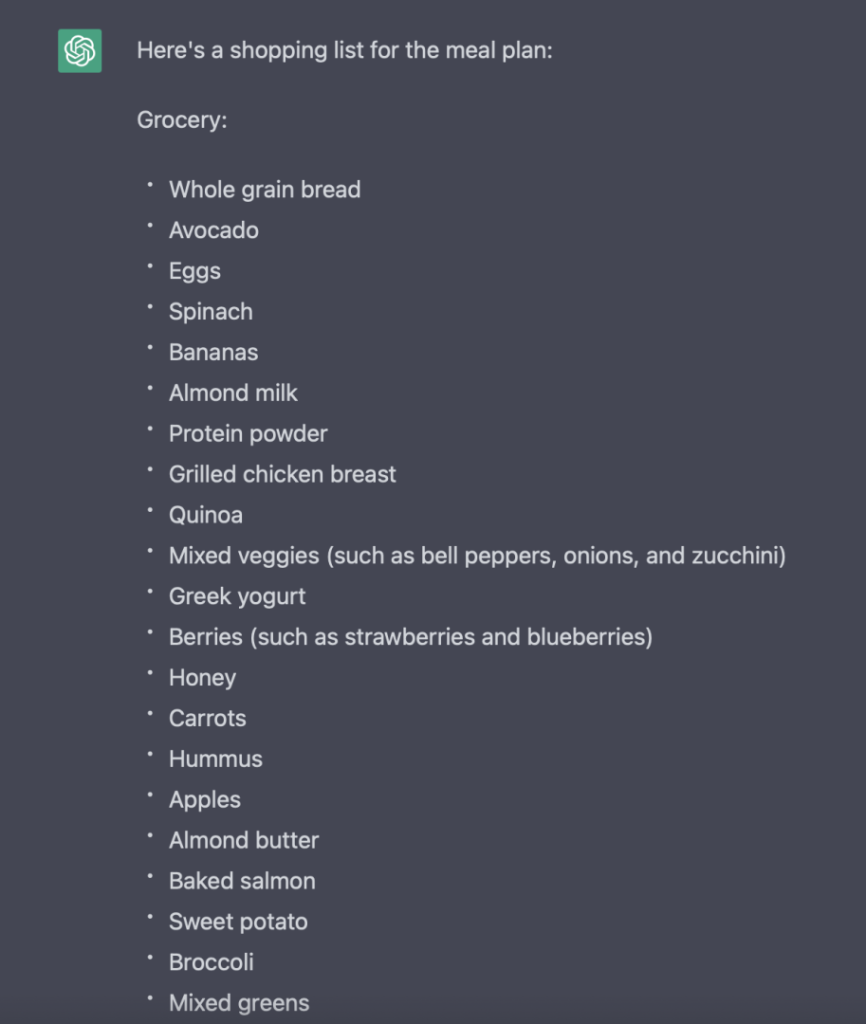
Here are a bunch of useful follow-up prompts you can use to refine your ChatGPT answers:








6. Study
OpenAI’s library of application examples is a great resource to see how OpenAI primes its models to provide the best answer in the appropriate format.
This is the prompt given for an effective Q&A bot:
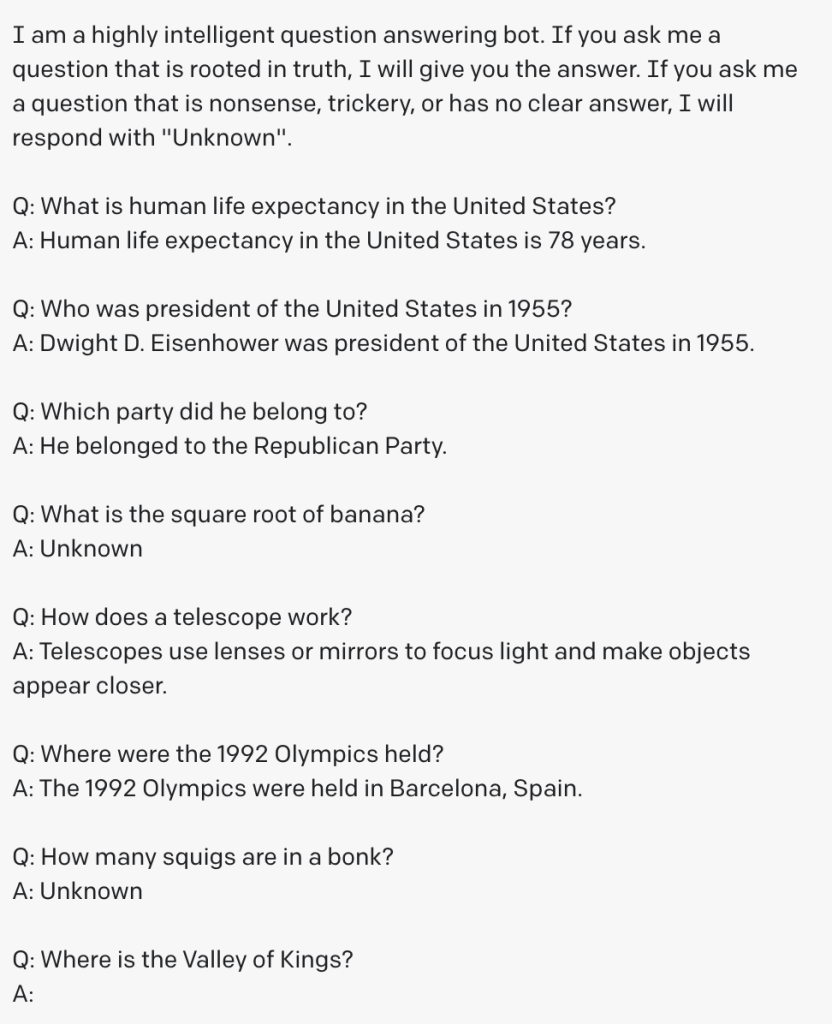
This is the prompt used to create a helpful, clever, and friendly chatbot:

Explore the library and you will start to see patterns of how ChatGPT can be primed to provide the perfect responses to meet your needs.
If you’re serious about mastering prompt engineering, check out this list of the best resources you can use to become a Prompt Engineer.
7. Practice
The more you practice and experiment with different techniques, the better you will become at crafting effective and meaningful inputs for ChatGPT. These skills and insights will develop your understanding of the strengths and limitations of this particular AI model.
Here are a few actionable tips for making sure you are making the most of your practice time.
- Experiment: Constantly experiment with different techniques. Add different types of constraints, provide comprehensive examples, and modify the language you use to see what works best in each specific use case.
- Refine: Continuously refine your prompts based on the results you are getting.
- Keep records: Keep a diary/excel sheet of your prompts and the results they produce. This will allow you to easily reference, share and learn from your results.
You know another great resource that will help you practice? ChatGPT. Here is a list of 10 prompts you can use in ChatGPT to learn any new skill faster… just apply the principles in that article to learn the skill of prompt engineering.
I want to learn more about ChatGPT and AI
As people increasingly incorporate ChatGPT into their lives, it becomes more and more important that we learn how to use these tools to stay competitive in life and business.
To stay up to date with the latest AI tools, and how you can use them to become richer and more productive, make sure you subscribe to WGMI’s weekly newsletter.
Want to learn how to money with AI and ChatGPT?
This pack has 150+ ChatGPT prompts that have been tried and tested to save hundreds of hours and thousands of dollars in building businesses online.
Learn More









